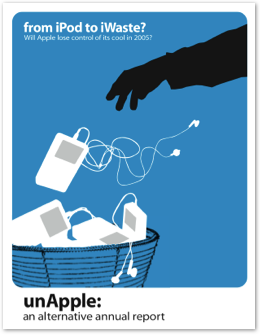




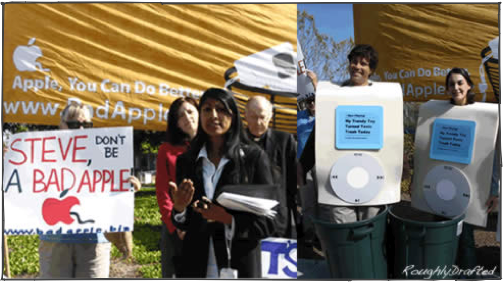
In 2005, the Silicon Valley Toxics Coalition targeted MacWorld, Apple's stockholder meeting, and other events to criticize the company's position on recycling and takeback programs for used computers. Here’s a look at the validity and competence of SVTC’s claims.
The Claims
The SVTC’s Computer Take Back Campaign webpage says that representatives “announced the campaign's intention to target Apple in 2005. Activists kicked off the campaign the next day at the MacWorld during Jobs annual speech.”
The group even registered its own badapple.biz domain name (proving, incidentally, that there is indeed a market for .biz name registries), for a “site to educate Apple users on the company's pollution practices.”
Outside Apple’s annual stockholder meeting, protesters waved banners calling the iPod "toxic trash, in your pocket" and handed out fliers suggesting that iPods were a major source of non recycled e-waste, because consumers would throw their iPods in the trash after the internal battery died, rather than pay to replace the battery.

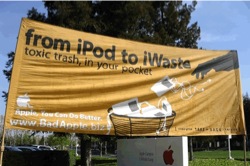

Protesters handed out a report that accused Apple of exploiting cheap third world and prison labor to sort though toxic e-waste, and complained that Apple does not take back as much e-waste as rivals HP or Dell.
Inside the meeting, Rachel Gibson, speaking on behalf of Green Century Funds as a stockholder, similarly criticized Apple's recycling efforts in comparison with HP and Dell.
Both groups choreographed their efforts to attach their message to Apple, singled the company out as having ineffectual environmental policies, and repeatedly pointed to Dell and HP as responsible stewards of the Earth.
Reality Check
The protesters were conspicuously silent about Apple's efforts to lead the industry in actually preventing unnecessary toxic trash, and made no comment about Al Gore sitting on Apple’s board. Was that simply an inconvenient truth ignored by the group’s campaign to vilify Apple?
In reality, the claims against Apple were simply misleading; they presented facts that were wholly unrelated to Apple, then mixed in the company's name and trademarks to arouse unsupported suspicion.
 The UnApple Report, issued by Silicon Valley Toxics Coalition and their partners, mixed generalized assumptions about Apple Computer, depictions of Apple products, and a spoofed Apple logo in with general facts about the environment and societal ills, and implied a correlation between the two. For example it stated:
The UnApple Report, issued by Silicon Valley Toxics Coalition and their partners, mixed generalized assumptions about Apple Computer, depictions of Apple products, and a spoofed Apple logo in with general facts about the environment and societal ills, and implied a correlation between the two. For example it stated:50-80% of the e-waste taken to U.S. “recyclers” is actually shipped out to developing countries in violation of international law. In China, India and other countries, dirty electronics recycling has had horrendous consequences—polluting the air, land and water and endangering people’s health. Without an aggressive takeback system, including a commitment to work only with responsible recyclers, Apple is contributing to this growing problem.
This suggested that Apple was involved in sending toxic trash to third world countries, which isn't true. SVTC knew that, so they only implied a relationship. Reports of the protest widely linked Apple to “accusations” of third world dumping, so a vague implication was enough to fulfill the coalition’s political agenda.
Apple lags far behind Dell and HP in its policies or programs to take back its own obsolete products.
This suggested that Dell and HP have actually recycled more of their PCs than Apple has, but that isn't true either. Dell and HP have both produced far more toxic trash than Apple, and continue to generate many times more e-waste than Apple, both in sheer volume and in the degree of toxicity of the new products they ship, as noted below.
A disturbing growth trend in e-waste recycling is the use of prison work programs where super-exploited, under-protected captive workers are subject to toxic exposure. Without a system in place to ensure that Apple e-waste does not end up in prisons, Apple is contributing to this growing problem.
This similarly implied that Apple was using prison labor for recycling, when SVTC knew that Apple really wasn't.
Under a depiction of an iPod being thrown away, the report presented various facts about lead poisoning and the toxicity of burning plastics, but headlined the general statements with:
Many manufacturers are addressing the problems associated with electronic waste, or e-waste. Apple, however, is compromising brand value and leadership by placing short-term financial gain over environmental concerns. Apple products include toxics, and need special care.
Was the iPod targeted because it is a serious contributor to e-waste, or was SVTC targeting Apple because their brand name and consumer popularity would guarantee it front page press coverage?
The Facts
Would it be better if the iPod used AA batteries, the way many other music players do? That would result in the tens of millions of iPod users each throwing away hundreds of toxic batteries throughout their iPods' lifetime.
A large contributing factor of improperly disposed mercury and other toxic heavy metals lies with disposable batteries that are frequently not recycled properly by consumers. Batteries should never be thrown in the trash. 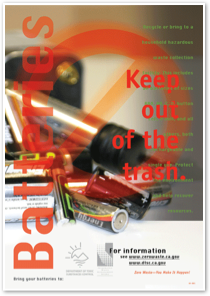

By replacing an older generation of Walkman-style music players, which ran through disposable batteries like candy, the iPod and devices like it have actually prevented the use of hundreds of millions of convenient, but toxic batteries that many consumers carelessly throw away rather than recycle.
According to the report Household Universal Waste Generation in California, August 2002, there were 507,259,000 batteries sold in California in the year 2001. According to survey results published in the report, only 0.55% of these batteries were recycled.
This spring, California instituted new regulations that prohibit any household batteries from being thrown in the trash. Why was the SVTC silent on the very real environmental issue posed by devices using disposable household batteries, and solved by players like the iPod?
Instead, the SVTC was waving banners and handing out reports depicting wastebaskets full of dead iPods. But is it really at all likely that consumers would throw away their iPod rather than buy a new battery? Why wouldn't they at least sell it to remanufactures, who readily pay more for a dead iPod than a used WMA player or Walkman?
The iPod's battery lasts for years; when it is replaced, the work is either done by professionals who know to recycle it, or by tech savvy consumers. A replacement iPod battery costs from $8.50 to $23.99, and full replacement service by Apple can cost as much as $65.00, including postage.
That’s around 20% of the cost of a new iPod, a significant barrier to the casual disposability of either the old battery or the entire player. Does the SVTC really think consumers throw away iPods, or were they maliciously playing up a fabrication they knew to be misleading, just to get themselves noticed?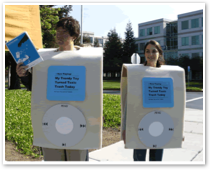

Sewing up iPod costume suits might have been a fun activity for the group to spend their contributors' donations on, but it did not deliver an accurate or relevant message about the environment, nor did it advocate responsibility for either consumers or the producers of electronics. It deceptively vilified the iPod in a PR stunt to bring attention to the group and their fundraising activities.
The Bad Wrap
What about the fact that new iPods and Macs ship in much less packaging than similar products from HP or Dell? And what about Apple's efforts to actively phase out the use of CRT displays, which contribute more of the toxins in hazardous e-waste than anything else in a computer system?
In 2005, the only CRT model Apple was still selling was the institutional eMac. Both HP and Dell were shipping thousands of tons of CRT displays in their low end, loss leader PCs to end consumers. Their CRT's alone amounted to far more toxic trash than all of Apple's Macs and iPods combined!
Not only were Dell and HP dumping far more cheap, disposable PCs with CRT displays, but all that extra e-waste was ending up in the consumer market segment that SVTC’s pamphlets targeted as the least likely to recycle its old equipment properly.

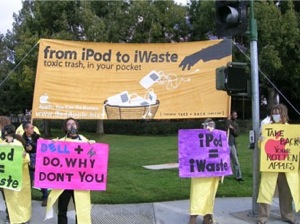

The fact that HP and Dell were spending more to advertise their takeback "goals" and make "commitments to the environment" didn't make HP and Dell more environmentally friendly. They were contributing far more to the worldwide e-waste problem than anyone else!
How long has HP been taking back PCs? What fraction of the PCs built by HP and Dell are actually getting recycled? Remember Apple's 2% share of the entire worldwide PC hardware market?
HP and Dell have goals recycle about as many PCs as Apple makes every year. That leaves a huge surplus of PC e-waste, dumped upon the least likely to recycle, and made up of the most toxic and the cheapest components, providing users with the least usable life span.
Why was the SVTC hailing HP and Dell as green leaders?
A Lot of Junk
The wastebasket full of iPods depicted by protesters was not only an inaccurate portrayal of the iPod, but also grossly distorted the reality of e-waste. How many of HP's disposable $299 PCs does it take to fill a wastebasket?
Since the average price of a PC is now under $500, Dell and HP clearly make up the majority of their PC sales by producing disposable quality machines at a low price point that demands the use of a far more toxic CRT display. These junk PCs will have a much shorter life span than an iPod, let alone a comparable Mac.
Not only are HP and Dell pumping out far more junk PCs with shorter useful life spans, but their reliance on cheaper CRT displays to hit the low price point demanded of disposable PCs means the mass market systems they specialize in contribute to far more of the world’s toxic and hazardous e-waste, regardless of whether it is being recycled by third world peasants, prison laborers, or illegally dumped in landfills by consumers who don't know any better.
In a June 2005 press release, the SVTC Computer Take Back Campaign’s vice chair Robin Schneider really highlighted the groups logical disconnect when she dismissed Apple’s iPod takeback program and asked, “What about the [1978] Apple II, the [1983] IIe, the [1990] Mac Classics that are being used as toxic doorstops?”
What is the relevance of the Apple II series? The majority of those two million II’s, sold two decades ago, have already been disposed. HP and Dell are churning out nearly 20 million new PCs every quarter! The only reason to be talking about old Apple computers is to keep bringing up Apple’s brand in connection with their politics.
 Continued Attack
Continued AttackSVTC's website regurgitates repeated attacks against Apple, clearly designed to use Apple's name and reputation to draw attention to the group and its fundraising. The attack has continued, devoid of any real facts, but carefully illustrated with an iconic Apple depicted with a worm.
The Silicon Valley Toxics Coalition hasn’t spent any time designing clever icons for other companies, nor has it promoted its takeback campaign by registering spoof DNS names targeting competitors.
Is Apple a target because of a cold corporate disregard for the environment, or simply because it is easier to find volunteers to jump around in an iPod costume or draw Apple icons with parasites than it is to research and present actual facts?
Sloppy With the Facts
The SVTC's prison labor charge against Apple was simply a copy and paste effort; the group attacked Dell in 2003 for using prison labor when Dell actually was using contractors who farmed out hazardous work to prisoners.
The prison labor attack on Apple however, was not based on Apple's actions, and the protesters knew that while they danced around in iPod suits and handed out pamphlets that linked Apple to prison labor e-waste issues.
After Jobs clarified at the stockholder meeting that Apple did not send e-waste to prison labor camps or to overseas recyclers, the SVTC posted a “Jobs Goes Ballistic About Earth Day Protest” blog entry on their website, saying that their protest prompted the CEO “to respond with angry statements to shareholders.” But that was a lie.
While SVTC protesters were outside, I was inside at that meeting. In reality, Jobs and other Apple executives sat through several long speeches by people associated with the group or Green Century Funds, and then presented a factual rebuttal to the claims in the UnApple pamphlet. Referring to Jobs’ response as either ballistic or angry is as inaccurate as SVTC’s other claims.
The group later backpedalled with the suggestion that they expected Apple to have systems in place to track down all the Macs ever produced, and that because it didn't, that made the company responsible for any Apple computers that were not properly recycled.
As proof, the SVTC insisted that workers in prison recycling systems recalled seeing old Macs run through the system. However, neither HP nor Dell has systems in place to rid the world of every PC they have produced, and certainly far more of their PCs end up getting dumped upon the third world and prison laborers.
What was SVTC trying to prove? Were they actually trying to prove anything, or was it simply a shotgun approach to make Apple look bad and portray themselves as an active group in the headlines, worthy of political campaign funding?
 The SVTC website is also proud to report having paid to fly airplane banners over Stanford to personally attack Steve Jobs as the CEO of Apple, when he spoke at graduation ceremony there later in the year.
The SVTC website is also proud to report having paid to fly airplane banners over Stanford to personally attack Steve Jobs as the CEO of Apple, when he spoke at graduation ceremony there later in the year. However, nowhere did the SVTC outline any metrics indicating any real issues with Apple's environmental record. Instead, the group hid behind supposition and comparisons with corporate announcements and published goals, and ignored Apple’s clear and obvious pro-environment actions.
By celebrating the grandstanding announcements of Dell and HP, the worlds largest PC polluters, and vilifying both the iPod and Apple's environmental record with misleading and inaccurate accusations, the SVTC protesters exposed themselves as self promoting frauds with no understanding of environmental issues, an no interest in facts.
The SVTC's parasitic sensationalism credited these groups for producing the “UnApple” smear report:
Basel Action Network
Center for Environmental Health
Clean Production Action
Clean Water Action
Silicon ValleyToxics Coalition
Texas Campaign for the Environment
Washington Citizens for Resource Conservation
Coming up: more dissection of Apple parasites: Greenpeace!
This Series

| | Comment Preview
 Read more about:
Read more about:

 Send |
Send |

 Subscribe |
Subscribe |
 Del.icio.us |
Del.icio.us |
 Digg |
Digg |
 Furl |
Furl |
 Reddit |
Reddit |
 Technorati
Technorati
Click one of the links above to display related articles on this page.
The SVTC’s “Toxic Trash” Attack on Apple
Friday, September 1, 2006






Ad




